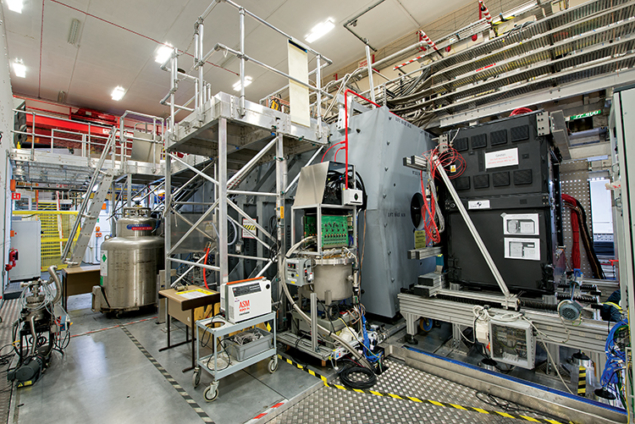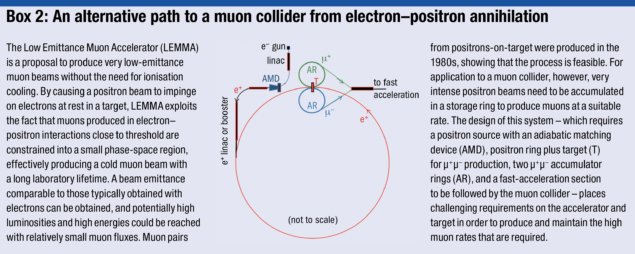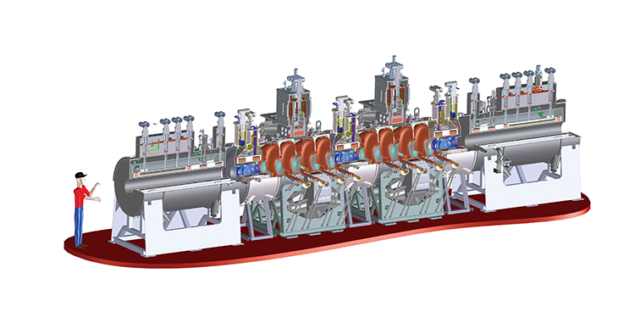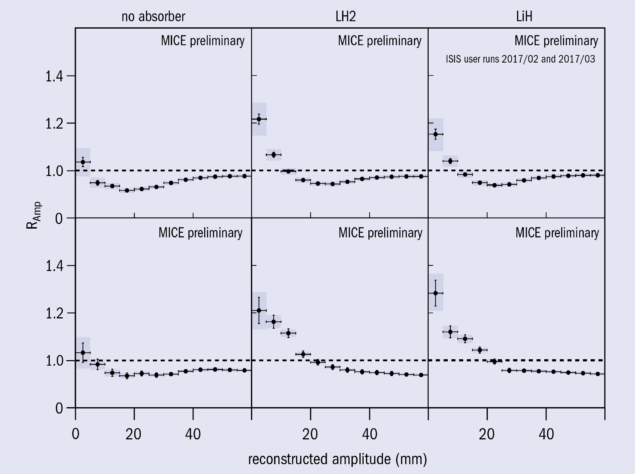The recent demonstration of muon ionisation-cooling by the MICE collaboration opens a path to a neutrino factory and muon collider.

Fundamental insights into the constituents of matter have been gained by observing what happens when beams of high-energy particles collide. Electron–positron, proton–proton, proton–antiproton and electron–proton colliders have all contributed to the development of today’s understanding, embodied in the Standard Model of particle physics (SM). The Large Hadron Collider (LHC) brings 6.5 TeV proton beams into collision, allowing the Higgs boson and other SM particles to be studied and searches for new physics to be carried out. To reach physics beyond the LHC will require hadronic colliders at higher energies and/or lepton colliders that can deliver substantially increased precision.
A variety of options are being explored to achieve these goals. For example, the Future Circular Collider study at CERN is investigating a 100 km-circumference proton–proton collider with beam energies of around 50 TeV the tunnel for which could also host an electron–positron collider (CERN Courier June 2018 p15). Electron–positron annihilation has the advantage that all of the beam energy is available in the collision, rather than being shared between the constituent quarks and gluons as it is in hadronic collisions. But to reach very high energies requires either a state-of-the-art linear accelerator, such as the proposed Compact Linear Collider or the International Linear Collider, or a circular accelerator with an extremely large bending radius.
Muons to the fore
A colliding-beam facility based on muons has a number of advantages. First, since the muon is a lepton, all of the beam energy is available in the collision. Second, since the muon is roughly 200 times heavier than the electron and thus emits around 109 times less synchrotron radiation than an electron beam of the same energy, it is possible to produce multi-TeV collisions in an LHC-sized circular collider. The large muon mass also enhances the direct “s-channel” Higgs-production rate by a factor of around 40,000 compared to that in electron–positron colliders, making it possible to scan the centre-of-mass energy to measure the Higgs-boson line shape directly and to search for closely spaced states.

Stored muon beams could also serve the long-term needs of neutrino physicists (see box 1). In a neutrino factory, beams of electron and muon neutrinos are produced from the decay of muons circulating in a storage ring. It is straightforward to tune the neutrino-beam energy because the neutrinos carry away a substantial fraction of the muon’s energy. This, combined with the excellent knowledge of the beam composition and energy spectrum resulting from the very well-known characteristics of muon decays, makes the neutrino factory the ideal place to make precision measurements of neutrino properties and to look for oscillation phenomena that are outside the standard, three-neutrino-mixing paradigm.
Given the many benefits of a muon collider or neutrino factory, it is reasonable to ask why one has yet to be built. The answer is that muons are unstable, decaying with a mean lifetime at rest of 2.2 microseconds. This presents two main challenges: first, a high-intensity primary beam must be used to create the muons that will form the beam; and, second, once captured, the muon beam must be accelerated rapidly to high energy so that the effective lifetime of the muon can be extended by the relativistic effect of time dilation.
One way to produce beams for a muon collider or neutrino factory is to harness the muons produced from the decay of pions when a high-power (few-MW), multi-GeV proton beam strikes a target such as carbon or mercury. For this approach, new proton accelerators with the required performance are being developed at CERN, Fermilab, J-PARC and at the European Spallation Source. The principle of the mercury target was proved by the MERIT experiment that operated on the Proton Synchrotron at CERN. However, at the point of production, the tertiary muon beam emerging from such schemes occupies a large volume in phase space. To maximise the muon yield, the beam has to be “cooled” – i.e. its phase-space volume reduced – in a short period of time before it is accelerated.

The proposed solution is called ionisation cooling, which involves passing the beam through a material in which it loses energy via ionisation and then re-accelerating it in the longitudinal direction to replace the lost energy. Proving the principle of this technique is the goal of the Muon Ionization Cooling Experiment (MICE) collaboration, which, following a long period of development, has now reported its first observation of ionisation cooling.
An alternative path to a muon collider called the Low Emittance Muon Accelerator (LEMMA), recently proposed by accelerator physicists at INFN in Italy and the ESRF in France, provides a naturally cooled muon beam with a long lifetime in the laboratory by capturing muon–antimuon pairs created in electron–positron annihilation (see box 2).
Cool beginnings
The benefits of a collider based on stored muon beams were first recognised by Budker and Tikhonin at the end of the 1960s. In 1974, when CERN’s Super Proton Synchrotron (SPS) was being brought into operation, Koshkarev and Globenko showed how muons confined within a racetrack-shaped storage ring could be used to provide intense neutrino beams. The following year, the SPS proton beam was identified as a potential muon source and the basic parameters of the muon beam, storage ring and neutrino beam were defined. It was quickly recognised that the performance of this facility—the first neutrino factory to be proposed – could be enhanced if the muon beam was cooled. In 1978, Budker and Skrinsky identified ionisation cooling as a technique that could produce sufficient cooling in a timeframe short compared to the muon lifetime and, the following year, Neuffer proposed a muon collider that exploited ionisation cooling to increase the luminosity.
The study of intense, low-emittance muon beams as the basis of a muon collider and/or neutrino factory was re-initiated in the 1990s, first in the US and then in Europe and Japan. Initial studies of muon production and capture, phase-space manipulation, cooling and acceleration were carried out and neutrino- and energy-frontier physics opportunities evaluated. The reduction of the tertiary muon-beam phase space was recognised as a key technological challenge and at the 2001 NuFact workshop the international MICE collaboration was created, comprising 136 physicists and engineers from 40 institutes in Asia, Europe and the US.

The MICE cooling cell, in common with the cooling channels studied since the seminal work of the 1990s, is designed to operate at a beam momentum of around 200 MeV/c. This choice is a compromise between the size of the ionisation-cooling effect and its dependence on the muon energy, the loss rate of muon-beam intensity through decay, and the ease of acceleration following the cooling channel. The ideal absorber has, at the same time, a large ionisation energy loss per unit length (to maximise ionisation cooling) and a large radiation length (to minimise heating through multiple Coulomb scattering). Liquid hydrogen meets these requirements and is an excellent absorber material; a close runner-up, with the practical advantage of being solid, is lithium hydride. MICE was designed to study the properties of both. The critical challenges faced by the collaboration therefore included: the integration of high-field superconducting magnets operating in a magnetically coupled lattice; high-gradient accelerating cavities capable of operation in a strong magnetic field; and the safe implementation of liquid-hydrogen absorber modules – all solved through more than a decade of R&D (see box 3).
In 2003 the MICE collaboration submitted a proposal to mount the experiment (figure 1) on a new beamline at the ISIS proton and muon source at the Science and Technology Facilities Council’s (STFC) Rutherford Appleton Laboratory in the UK. Construction began in 2005 and first beam was delivered on 29 March 2008. The detailed design of the spectrometer solenoids was also carried out at this time and the procurement process was started. During the period from 2008 to 2012, the collaboration carried out detailed studies of the properties of the beam delivered to the experiment and, in parallel, designed and fabricated the focus-coil magnets and a first coupling coil.

Delays were incurred in addressing issues that arose in the manufacture of the spectrometer solenoids. This, combined with the challenges of integrating the four-cavity linac module with the coupling coil, led, in November 2014, to a reconfiguration of the MICE cooling cell. The simplified experiment required two, single-cavity modules and beam transport was provided by the focus-coil modules. An intense period of construction followed, culminating with the installation of the spectrometer solenoids and the focus-coil module in the summer of 2015. Magnet commissioning progressed well until, a couple of months later, a coil in the downstream solenoid failed during a training quench. The modular design of the apparatus meant the collaboration was able to devise new settings rapidly, but it proved not to be possible to restore the downstream spectrometer magnet to full functionality. This, combined with the additional delays incurred in the recovery of the magnet, eventually led to the cancellation of the installation of the RF cavities in favour of the extended operation of a configuration of the experiment without the cavities (see schematic in box 3).
It is interesting to reflect, as was done in a recent lessons-learnt exercise convened by the STFC, whether a robust evaluation of alternative options for the cooling-demonstration lattice at the outset of MICE might have identified the simplified lattice as a “less-risky” option and allowed some of the delays in implementing the experiment to be avoided.

The bulk of the data-taking for MICE was carried out between November 2015 and December 2017, using lithium-hydride and liquid-hydrogen absorbers. The campaign was successful: more than 5 × 108 triggers were collected over a range of initial beam momentum and emittance for a variety of configurations of the magnetic channel for each absorber material. The key parameter to measure when demonstrating ionisation cooling is the “amplitude” of each muon – the distance from the beam centre in transverse phase space, reconstructed from its position and momentum. The muon’s amplitude is measured before it enters the absorber and again as it leaves, and the distributions of amplitudes are then examined for evidence of cooling: a net migration of muons from high to low amplitudes. As can be seen (figure 2), the particle density in the core of the MICE beam is increased as a result of the beam’s passage through the absorber, leading to a lower transverse emittance and thereby providing a higher neutrino flux or a larger luminosity.
The MICE observation of the ionisation-cooling of muon beams is an important breakthrough, achieved through the creativity and tenacity of the collaboration and the continuous support of the funding agencies and host laboratory. The results match expectations, and the next step would be to design an experiment to demonstrate cooling in all six phase-space dimensions.
Completing the MICE programme
Having completed its experimental programme, MICE will now focus on the detailed analysis of the factors that determine ionisation-cooling performance over a range of momentum, initial emittance and lattice configurations for both liquid-hydrogen and lithium-hydride absorbers. MICE was operated such that data were recorded one particle at a time. This single-particle technique will allow the collaboration to study the impact of transverse-emittance growth in rapidly varying magnetic fields and to devise mechanisms to mitigate such effects. Furthermore, MICE has taken data to explore a scheme in which a wedge-shaped absorber is used to decrease the beam’s longitudinal emittance while allowing a controlled growth in its transverse emittance. This is required for a proton-based muon collider to reach the highest luminosities.
With the MICE observation of ionisation cooling, the last of the proof-of-principle demonstrations of the novel technologies that underpin a proton-based neutrino factory or muon collider has now been delivered. The drive to produce lepton–antilepton collisions at centre-of-mass energies in the multi-TeV range can now include consideration of the muon collider, for which two routes are offered: one, for which the R&D is well advanced, that exploits muons produced using a high-power proton beam and which requires ionisation cooling; and one that exploits positron annihilation with electrons at rest to create a high-energy cold muon source. The high muon flux that can be achieved using the proton-based technique has the potential to serve a neutrino-physics programme of unprecedented sensitivity, and the MICE collaboration’s timely results will inform the coming update of the European Strategy for Particle Physics.
Further reading
MICE Collaboration 2018 arXiv:1806.01807.
D Adey et al. 2013 arXiv:1305.1419.
M Boscolo et al. 2018 arXiv:1803.06696.








